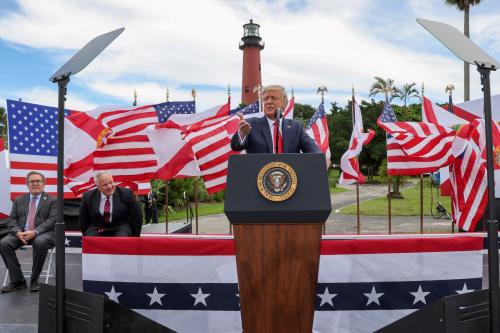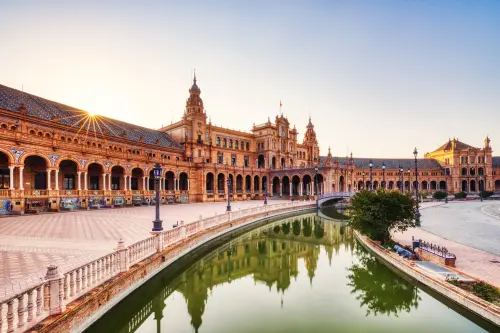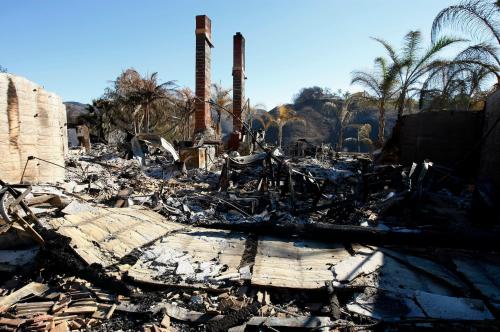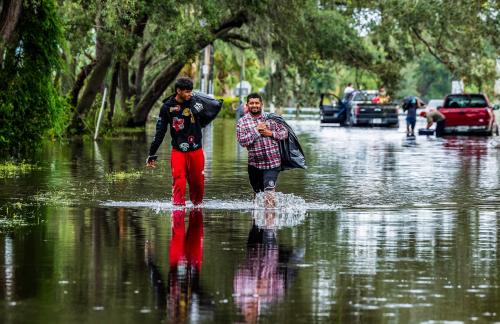Although there’s been a lot of progress in cutting the emissions that cause climate change, actually stopping and reversing climate change will require a whole lot more. Only by slashing emissions essentially to zero everywhere on the planet will the climate be allowed to heal itself. Achieving those kinds of deep cuts will probably require that countries work together more closely—to figure out who pays the cost of developing new technologies and to manage the effects of expensive emission controls on economic competitiveness.
The logic for deep cooperation is compelling, but that logic is a hard sell in today’s era of intensifying economic nationalism. Many of the world’s largest industrial economies, including the United States and China, see an economic advantage in investing in the technologies of a clean industrial future. What’s good for one country will be seen as a lost advantage for others. Cooperation is particularly hard to forge when that kind of zero-sum logic prevails. Institutions that could help achieve more cooperation, such as the World Trade Organization, are already fraying—not least because U.S. support for rules-based international cooperation has been waning. On top of that, for serious cooperation on climate change to move forward, the least developed countries will require money to help them pay the costs of adjustment to new energy systems as well as deal with the harsh impacts of climate change. Poor countries that didn’t cause global warming and are highly vulnerable to the impacts of a changing climate want compensation. Ponying up those funds is deeply unpopular in Washington and has been for a long time.
The two candidates for U.S. president, Kamala Harris and Donald Trump, have espoused radically different approaches to international cooperation. A President Trump would pull out of most international institutions where climate cooperation is discussed, just as he pulled out of the Paris Agreement during his first term in office. A Harris successor to the Biden administration would likely stay inside those institutions and engage. She and her vice-presidential pick, Minnesota Governor Tim Walz, have a long track record of supporting national policies that help cut emissions.
In practice, however, these diverging formal strategies may matter a lot less than they appear. The disruptions caused by a Trump electoral victory, and a subsequent U.S. exit from the international climate order, will be tempered. At first blush, it seems like nothing could be more destructive to international cooperation than exiting the Paris Agreement—and possibly also leaving the United Nations Framework Convention on Climate Change, a treaty negotiated by a Republican president in the early 1990s with long-standing U.S. support. But having the Trump administration formally on the outside would be less disruptive than if the United States were to adhere to the treaty while the Trump team caused mischief from within. That’s because many other governments around the world (led by much of Europe) along with many states and localities within the United States would react, as they did during the first Trump term, by showing that they are “still in.” Having rehearsed these scenarios already in 2017-2020, the Trump exit will probably happen faster in a second Trump term than during the first, but so will the counter-response from the rest of the world.
A Harris win in November would be less disruptive of the existing order. However, her team can’t erase the problem that global climate cooperation will require a lot more climate finance—including money from governments that the United States won’t supply. These tensions lurked in the background of the last big climate conference last November in Dubai, COP28. And just a week after the U.S. election, the curtain will rise on COP29 in Baku where these conflicts could be even more acute. The United States, under Harris, will do its best to act on climate change, but it will still need to overcome sticky conflicts over climate finance for the world’s poorest countries to advance climate diplomacy in Baku. The last time these roadblocks proved impassible—in 2009 in Copenhagen—climate cooperation went into a deep freeze for several years until new thinking and approaches could resurrect it.
Put bluntly, the next occupant of the White House matters less than the real barrier to international climate progress: money.
Why international cooperation matters
Cooperation matters not just because pollution comes from every nation on the planet and mixes throughout the global atmosphere. Cooperation is also important because cutting those emissions will cost money. As a general rule, when energy costs go up economic competitiveness can be harmed—both in reality and in political perception.
Additionally, creating new zero-pollution industries could re-sort the global economy and great power competition. The clean industries of tomorrow could be big employers and value-creators, which is why many countries—including China, the big European economies, the United States, Japan, and others—are investing heavily. Their goal isn’t just to clean up their economies but also to occupy the commanding heights of the future economy.
Because action on climate change affects competitiveness, cooperation implicates the nuts and bolts of the global economic system, such as the World Trade Organization, investment treaties, and systems for development assistance. Rebuilding the economy to be greener is no less ambitious than transforming much of the whole economy, which is one reason that industrial policy is back in vogue. Given how much is at stake, there are strong incentives for countries to seek self-advantage. Countries, including the United States, are adopting tariffs and blocking cross-border investments so they can be sure that their companies can thrive in future industries. The U.S. approach to China—with high and rising tariffs on many green products—is particularly striking. The green industrial revolution could emerge in ways that promote global trade and engagement or undermine them.
What kinds of international cooperation matter?
The climate problem has been reliably on the international agenda since the late 1980s. During most of that history, “international cooperation” has primarily referred to global cooperation forged by diplomatic agreements negotiated under the auspices of the United Nations. The first big treaty on climate change, the 1992 U.N. Framework Convention on Climate Change (UNFCCC), included nearly every nation on the planet. Every member of that treaty agreed to its content, which is why the agreement’s key provisions are steeped in complicated and convoluted wording—every country could see in the treaty its interpretation of what was agreed. The first protocol to that treaty, the 1997 Kyoto Protocol, also had nearly universal participation in the drafting, although the United States and a few other countries never ratified the agreement.
The architects of those global treaties thought they were following the successful model established during the international effort to save the ozone layer. But the two experiences—ozone and climate change—could not be more different in their success. The ozone accords have succeeded because they focused innovation and technological change on solutions to ozone depletion. They created incentives for firms and governments to invest in new technologies along with mechanisms that could figure out which new technologies were most promising.
For a couple of decades, by contrast, most diplomacy on climate change wasn’t focused on innovation and problem solving. Rather, the climate accords were mostly a cauldron of gridlock and inaction. Diplomats were good at going to meetings and crafting vague global agreements, but those agreements had little impact on underlying behavior. Along the way, policymakers learned that there were real trade-offs between global participation and the content of the agreements they could reach. When that content was legally binding, the trade-offs were particularly acute because no nation wanted to sign up for an agreement it couldn’t honor.
By the early 2010s, after more than two decades of diplomacy on climate change, there wasn’t much real action to cut emissions to show for all the diplomacy. A new approach was needed. The 2015 Paris Agreement marked a sharp break. The innovation in Paris was flexibility: the agreement lets countries set their own obligations and then adjust them periodically. Countries willing to do more pledge more. And most countries pledge more than they can deliver, which is tolerable because the pledges aren’t binding—they can be adjusted with experience and learning. Since the adoption of this new approach, careful empirical research has shown that more aggressive pledging has also led to more credible and aggressive national policies. Paris is a global agreement, but it is designed to allow countries to advance their climate policies at different speeds. Because of that design—indeed, because of that political realism—Paris is working and the trajectory of emissions is coming down.
In addition to global cooperation, there are now lots of “smaller” forms of cooperation that involve just a few countries and firms in key sectors or just small clubs of countries that are willing to take action. We used to call these “coalitions of the willing” —although that phrase was poisoned by the second U.S. venture into Iraq, which didn’t go well, and thus the community is still struggling to find the right language. Most of these just get called “climate clubs.”
Since 1995, the climate community has met annually for a global “conference of the parties” (COP) that is the formal meeting of all the countries that have joined the UNFCCC. At COP26 in 2021, interest in climate clubs exploded. Hosted in Glasgow by the British government, COP26 followed a theory of change that relied on doing what was possible through the global U.N. framework and then advancing most of the hard work—such as coordinating and funding new investments in clean steel production, or sales of alternative aviation fuels—in smaller clubs of the willing.
What if Trump wins in November?
If Donald Trump returns to the White House after the November election, then it is clear that one of his first actions will be to pull the United States out of the Paris Agreement. Trump has already done that once before and has promised a repeat performance if elected. On top of that, it’s pretty easy to pull out of the treaty, which has not been ratified by the Senate. In tandem, the United States will also probably stop overt funding of climate assistance to other countries, although current U.S. funding of that type is already pretty small. Whether the Trump team would be able to root out all the other ways that U.S.-backed institutions, like the World Bank, direct funding for climate purposes remains to be seen.
Depending on who has the president’s ear—which is hard to pin down at team Trump—his administration might also try to exit the UNFCCC. Legally, that’s a bit harder because the United States joined that treaty through the Senate ratification process and leaving might require new Senate action. (Analysts disagree.)
Most folks steeped in climate diplomacy think it will be a disaster if the United States leaves the Paris Agreement and an even bigger disaster if the country exits the UNFCCC altogether. I’m not so sure. Having the United States formally inside a system that the Trump presidency aims to undermine is probably worse than having the United States leave. Under the George W. Bush administration, when the United States was part of the UNFCCC but refused the joint the Kyoto Protocol, U.S. diplomats caused endless mischief that probably slowed progress (though the U.S. position was sympathetic to many other countries, including Saudi Arabia).
Even if the Trump administration ignores (or tries to undermine) official international cooperation on climate change, most of the clubs will keep clubbing. The United States has been a key architect of those clubs—climate envoy John Kerry’s team pushed, in tandem with COP26, the “first movers coalition” that was basically a coalition of the willing, including the United States. If the U.S. federal government turns hostile to climate cooperation, then lots of other countries—notably led by Europe—will be motivated to do more. Multinational firms and private industry in the United States and abroad are also significantly involved in nearly all these clubs—they are likely to keep working on climate action because they look, typically, beyond the tenure of any president when making long-term investments.
It is harder to pin down what China would do in response to Trump’s reelection and a U.S. withdrawal from the Paris Agreement. We might see the emergence of a more active Chinese climate strategy aimed at pushing Chinese products and clean energy investments to other countries. That would yield, in climate, what is already evident in many other areas of international cooperation—competing blocks of power and no central strategy (see here and here). All told, a more active Chinese engagement on climate would probably help improve cooperation—if that engagement included active efforts to keep markets for clean technology products (many exported from China) open for trade.
A Trump administration hostile to climate action will also invigorate some U.S. states—the blue ones—that previously redoubled their climate policy efforts because being anti-Trump on a signature environmental issue was good politics for their democratic bases. State-based action soared, including actions by key states like California—actions that, because such state economies dwarf those of many countries’, were tantamount to a national-level foreign policy on climate change. In 2018, for example, California Governor Jerry Brown hosted a Global Climate Action Summit in San Francisco and invited world leaders to talk about cooperation with California since the federal government, under Trump, was not available.
How a Trump victory might affect American credibility
The really big impact of a Trumpian exit from climate cooperation may not be on immediate cooperation. Other countries and states will fill in many, if not all, of the gaps in funding that would be lost. The really big harm will be to U.S. credibility—the feeling that the world can’t rely on the United States to put together and hold together international arrangements for cooperation on important problems like climate change.
When Trump won the U.S. presidential election in 2016, his victory occurred in the middle of COP22, the two-week global climate conference that was hosted in Marrakech, Morocco. The U.S. delegation, which formally worked for President Barack Obama but knew who was coming next, was dispirited and the rest of the world was in shock. This time, the rest of the world, to varying degrees, already expects the outcome. The U.S. election will be November 5 and COP29, held in the oil-rich country of Azerbaijan, will open the next week in Baku. If Trump wins, American diplomats will be walking the halls of COP29 with little to do that other countries will find credible.
How the world might view a Harris victory in November
It is easier to predict what will happen if a Harris administration succeeds the Biden one: Not much will change, formally, and the United States will remain engaged at international institutions focused on climate change.
One immediate expression of this formal commitment to the UNFCCC and to the Paris Agreement will be an update to the United States’ pledge for action under the Paris Agreement—known as a nationally determined contribution (NDC). Every five years, all countries are expected to submit updated NDCs; the next round of updates is expected in early 2025 and will form part of the agenda for COP30, which will be hosted by Brazil.
Biden’s first NDC pledged that the United States would adopt policies to cut emissions by about 50%-52% from 2005 levels by 2030. Actual emission cuts in 2030 will probably be more like 37%, with a lot of uncertainty related to the cost of fossil fuels, the pace of technology, the ease of building clean energy projects, and other factors. A new NDC will look further into the future with newly aggressive goals that, most likely, will be newly implausible. Absent a big win for Democrats and control over both houses of Congress, new legislation on climate change is highly unlikely.
The Biden/Harris administration has done more to advance national climate policy, notably with the Inflation Reduction Act (IRA), than any prior administration. But the economy doesn’t change quickly, the IRA by itself won’t transform the incentives for clean energy, and it is hard to decarbonize an economy entirely with subsidies and no strong sticks such as carbon taxes and regulations. Supreme Court hostility to agency delegation, such as the recent decision to abandon extensive deference to regulatory agencies when they interpret the meaning and scope of statutes, will also constrain a future Harris administration’s ability to work with existing laws to regulate greenhouse gas pollution. (Most environmentalists see this shift in legal precedent as a disaster for environmental regulation. But on climate change, I am not convinced it will matter much because most of the serious action pushing firms to cut emissions isn’t coming from federal regulatory agencies deep in the weeds of interpreting vague statutory authorities. For an overview, see this.)
The Harris administration’s biggest challenges for international cooperation related to climate change don’t lie with the UNFCCC and the Paris Agreement. Those are friendly forums that aren’t that demanding. The biggest issues are trade and investment. Many countries, led by China, are upset about U.S. tariffs on imported clean energy products. They can’t really take their grievances to the World Trade Organization (WTO)—because the United States under Trump and Biden has refused to appoint members of the WTO’s Appellate Body that is the final arbiter of trade disputes.
Being tough on trade while subsidizing the production of clean energy products here in the United States and in friendly countries (“friendshoring”) is central to Bidenomics. But the problem with this logic is that we can’t (and shouldn’t) build everything we need here in the United States. And it isn’t clear which countries count as “friends.” You’d think that European nations would be reliable friends, but the IRA and other policies aimed at promoting industrial policy don’t create a special advantage for our friends in Europe. Moreover, lots of projects will create inconvenient politics will abound. Saudi Arabia is looking at a clean energy supply project in Morocco (a country that has a Free Trade Agreement with the United States and is thus a logical “friend” with easy access to the U.S. market) that will generate U.S. political backlash as it becomes visible. Mexico is the place where such investments made with an eye to the U.S. market will become most conflictual because of the politicization of the U.S.-Mexico relationship and the looming renegotiation of the U.S.-Mexico-Canada free trade agreement known as “USMCA.”
What the rest of the world thinks
To some degree, diplomats in other countries know what to expect from the winner of the 2024 presidential election—because they have studied and lived through them already. As a general rule, governments keen to advance cooperation on climate change strongly favor a Harris victory because continuity with Biden means that the United States will reliably stay inside the Paris Agreement and reliably attempt to cooperate with other countries.
But even if Harris wins, the global flavor of international cooperation on climate change faces some big challenges that no U.S. administration is in a position to solve.
A key role for international cooperation lies with helping developing countries—especially the least developed nations that are highly vulnerable to the impacts of a problem that they, mostly, did not cause. Much of the most challenging diplomacy in global climate cooperation deals with mobilizing and spending the money needed to help these nations. Traditionally, most of that help has gone toward cutting emissions. But increasingly, assistance is needed to help build resilience against the physical impacts of climate change. Some countries, like low-lying island nations, may actually get wiped off the map from rising seas and storm surges.
Back in 2009, Western governments, led by the United States, promised to deliver $100 billion per year in new climate-related funding for developing countries. Although it took longer than desired, that goal was finally met last year. In Baku, there will be efforts to update that goal for the future, known in the jargon as the “New Collective Quantified Goal on Climate Finance.” In tandem, a new funding system has been created specifically to help countries that suffer “loss and damage” from climate change—that funding mechanism now exists formally but has almost no actual funding. European and other governments have offered significant funding through these mechanisms, but a similar move is deeply unpopular here in the United States.
Quite apart from whoever wins the U.S. election this November, the COP29 meeting that will begin the week after election day may mark a failure of the COP process—because anger in developing countries at the lack of more funding may boil over. Only once before, in 2009 in Copenhagen, did such a high-profile climate event end in failure—in that case, developing country concerns about lack of funding and voice were central causes. When it boils over this time, the blame may get pinned on the United States as a wealthy nation that has been a stingy funder—and if Trump wins his victory, in particular, he might attract the blame. Blame aside, the real problems are deeply structural—the most vulnerable developing countries are understandably upset that they are suffering the impacts of climate change yet aren’t being helped much by the countries responsible for most of the pollution. No matter who sits in the White House, the political support for a big funding program will be elusive.
-
Acknowledgements and disclosures
The author would like to thank Adam Lammon for editing and Steve Carlson and Samantha Gross for their assistance on this essay.
The Brookings Institution is committed to quality, independence, and impact.
We are supported by a diverse array of funders. In line with our values and policies, each Brookings publication represents the sole views of its author(s).







Commentary
How will climate cooperation look after the elections?
August 13, 2024